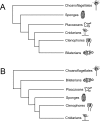A new look at some old animals
- PMID: 19175289
- PMCID: PMC2631055
- DOI: 10.1371/journal.pbio.1000007
A new look at some old animals
Abstract
How the tiny marine animalTrichoplax adhaerens is related to other animals has long puzzled researchers studying the origin of metazoans. An ambitious "total evidence" study provides careful analysis of this question and reveals some surprises.
Figures


Comment on
-
Concatenated analysis sheds light on early metazoan evolution and fuels a modern "urmetazoon" hypothesis.PLoS Biol. 2009 Jan 27;7(1):e20. doi: 10.1371/journal.pbio.1000020. PLoS Biol. 2009. PMID: 19175291 Free PMC article.
References
-
- Grell KG, Ruthman A. Placozoa. In: Harrison FW, Westfall JA, editors. Microscopic anatomy of invertebrates. Volume 2. Placozoa, Porifera, Cnidaria, and Ctenophora. New York: Wiley-Liss; 1991. pp. 13–27.
-
- Schierwater B. My favorite animal, Trichoplax adhaerens . BioEssays. 2005;27:1294–1302. - PubMed
-
- Ax P. Multicellular animals: A new approach to the phylogenetic order in nature. Volume 1. Berlin: Springer; 1996. p. 225.
-
- Pearse VB, Voigt O. Field biology of placozoans (Trichoplax): Distribution, diversity, biotic interactions. Integr Comp Biol. 2007;47:677–692. - PubMed
-
- Syed T, Schierwater B. Trichoplax adhaerens: Discovered as a missing link, forgotten as a hydrozoan, re-discovered as a key to metazoan evolution. Vie Milieu. 2002;52:177–187.
Publication types
MeSH terms
Substances
LinkOut - more resources
Full Text Sources

